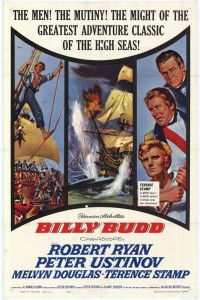The Men!.. The Mutiny!…The Might!… The Magnitude Of Herman Melville’s Classic Adventure of the High Seas!
What a wonderful experience viewing 1962’s Billy Budd, a film I was not previously acquainted with, was. Having not read the Hermann Melville work on which the film was based, the poster art drew me in as the potential viewing for the night. The poster sports a front and center shot of a man-of-war in action. Definitely up my alley.
Unfortunately, there is no action in the film- though the fight implied on the poster does technically happen at the extreme end of the film. But the drama is palpably as tangible as and gun battle.
Fortunately, what Billy Budd offers is much better than mere cannon play. It is a terribly gripping drama of an impressed and naïve seamen, Billy Budd (played by Terence Stamp). Billy doesn’t have a bad bone or thought in his body and perhaps his only fault is an inability to speak when overcome with emotion.
Budd is directed and also stars Peter Ustinov as the British ship’s captain, Captain Vere. Robert Ryan, almost alone among the cast in missing an English accent (and thankfully he didn’t put one on), play the ships demonic Master of Arms, John Claggart.
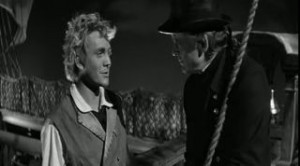 Claggart terrorizes the men, often times creating or exaggerating offenses to maintain his draconian control of the ship. Budd, in his innocence, attempts to befriend Claggart, who-though tempted, pushes him away, feeling that Budd too would try to “charm” him. In truth Budd feels pity and attempts to genuinely befriend Claggart, but Claggart’s warped perspective sees this only as a devious way to curry favor.
Claggart terrorizes the men, often times creating or exaggerating offenses to maintain his draconian control of the ship. Budd, in his innocence, attempts to befriend Claggart, who-though tempted, pushes him away, feeling that Budd too would try to “charm” him. In truth Budd feels pity and attempts to genuinely befriend Claggart, but Claggart’s warped perspective sees this only as a devious way to curry favor.
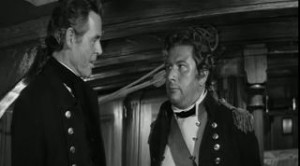 Claggart goes to the Captain and fabricates assertions that Budd is not only involved in, but leading a potential mutiny. When confronted with the accusation, Budd finds it impossible to verbalize his response, but as his only available means of emotion, strikes Claggart once, but kills him in the process.
Claggart goes to the Captain and fabricates assertions that Budd is not only involved in, but leading a potential mutiny. When confronted with the accusation, Budd finds it impossible to verbalize his response, but as his only available means of emotion, strikes Claggart once, but kills him in the process.
Captain Vere calls a court martial against Budd to investigate the incident. Throughout the trial the Captain and the court want to find Budd innocent. Not only do they know of Claggart’s baiting tendencies and harsh riding on the men, they genuinely find Budd a likeable chap. But the court is torn and ultimately decides that regardless of the cause he did strike and kill a superior officer and must pay the price.
At first I was amused and put off a bit by Ryan’s inclusion in the film as his lack of accent draws additional attention to him, given the preponderance of accents with the balance of the cast. Within a few moments, however, you realize that this may be Ryan’s best role and best performance.
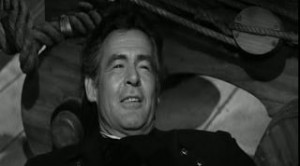 He completely personifies the evil and mean spirited Claggart- in retrospect it is as close to a perfect performance as I’ve seen from Ryan. There is an especially good scene between him and Budd topside (the one I alluded to above), where you can visibly see his emotions change just by looking at his eyes. You can tell that Claggart would like to be amiable, perhaps even have a friend aboard. He envies Budd in this regard. His eyes soften momentarily with eagerness, but then their usual hard stare return as Claggart rebuffs Budd. Masterful casting.
He completely personifies the evil and mean spirited Claggart- in retrospect it is as close to a perfect performance as I’ve seen from Ryan. There is an especially good scene between him and Budd topside (the one I alluded to above), where you can visibly see his emotions change just by looking at his eyes. You can tell that Claggart would like to be amiable, perhaps even have a friend aboard. He envies Budd in this regard. His eyes soften momentarily with eagerness, but then their usual hard stare return as Claggart rebuffs Budd. Masterful casting.
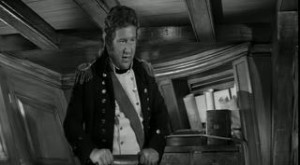 After Claggart’s death Ustinov takes over the picture from him. As the Captain he has a soft and endearing, but still firm approach. He doesn’t want to see Budd hang, but is obviously torn between what is just and what called for under law. It is an interesting predicament, and one that even society perhaps has yet to resolve.
After Claggart’s death Ustinov takes over the picture from him. As the Captain he has a soft and endearing, but still firm approach. He doesn’t want to see Budd hang, but is obviously torn between what is just and what called for under law. It is an interesting predicament, and one that even society perhaps has yet to resolve.
Throughout the picture Terence Stamp (Billy Budd) in his debut does a fine job of portraying naivety and a constant positive outlook. As good as he is though he is overshadowed by Ustinov and especially Ryan.
Billy Budd also marks one of Ustinov’s somewhat infrequent appearances behind camera, and the results could not be more pleasing. From the quirky credits, where cast members introduce themselves audibly, to the final shot, the picture is very well filmed. Ocean shots are well done and show the right scale of open spaces- and bowsprits don’t show those telltale oversize waves which always betray the use of a model.
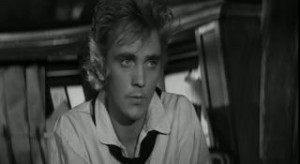 In addition, interior scenes are equally claustrophobic, especially in the scene outside the Captain’s cabin. Atmosphere is built further by a constant slight creaking throughout the picture during interiors. It is done in a very subtle way, and the sway of lanterns and the like is slight and gentle. Neither would likely be handled as such today.
In addition, interior scenes are equally claustrophobic, especially in the scene outside the Captain’s cabin. Atmosphere is built further by a constant slight creaking throughout the picture during interiors. It is done in a very subtle way, and the sway of lanterns and the like is slight and gentle. Neither would likely be handled as such today.
Part of this fine effort is done with the use of an actual recreated man-of war. Hard to beat the real thing, isn’t it?
One wonders why the film isn’t more popular today. It is rarely shown and when it does make a rare appearance on the tube, it is usually a cropped pan and scan version. Thankfully TCM usually airs it in the proper Cinemascope aspect ratio, which is the only way to see this fine epic.
